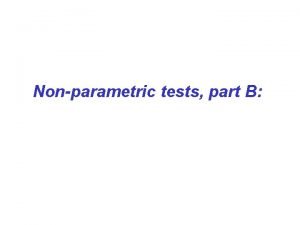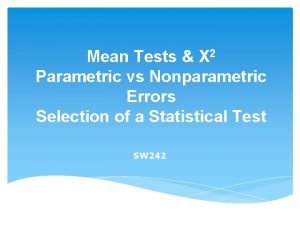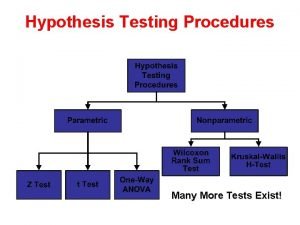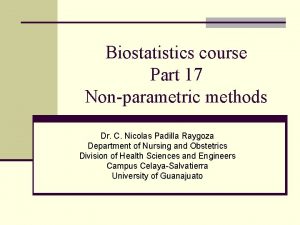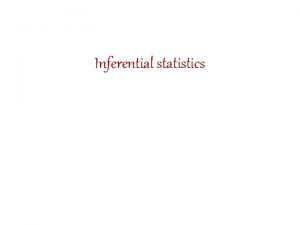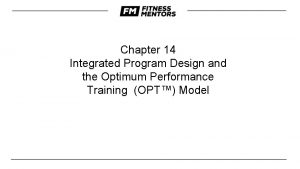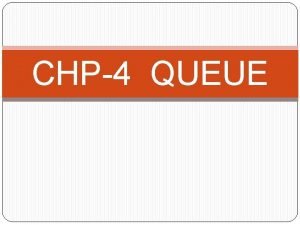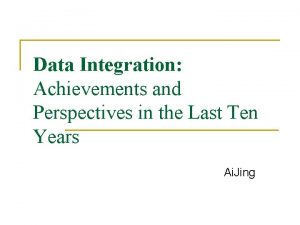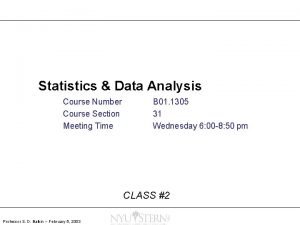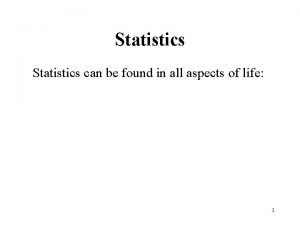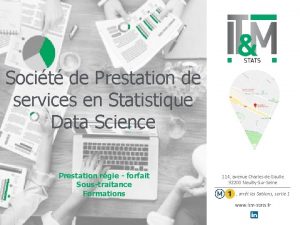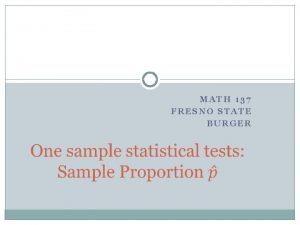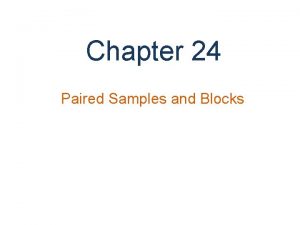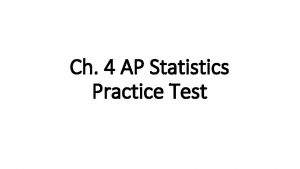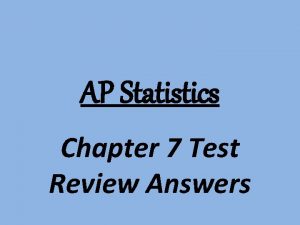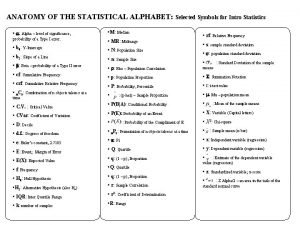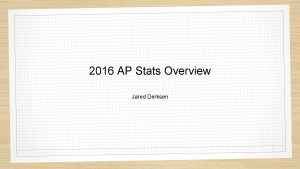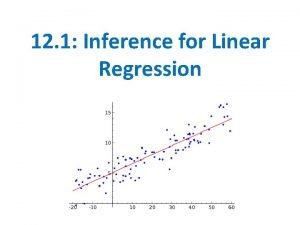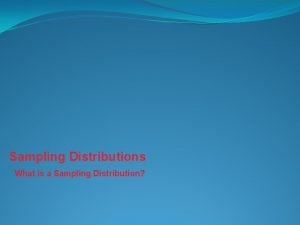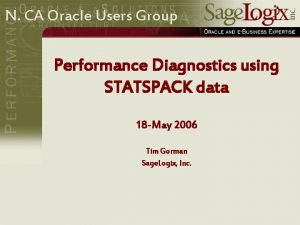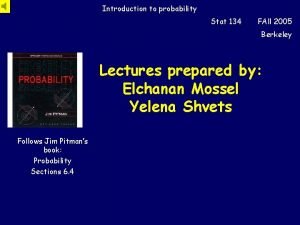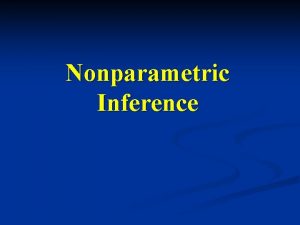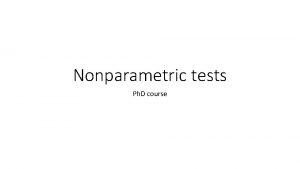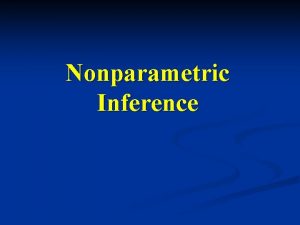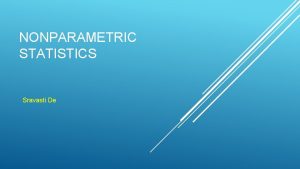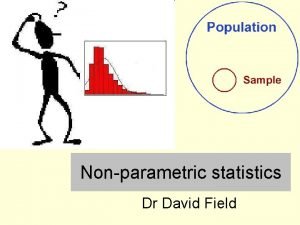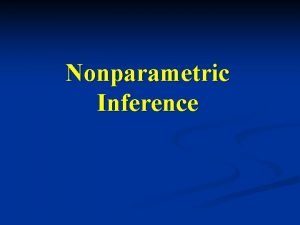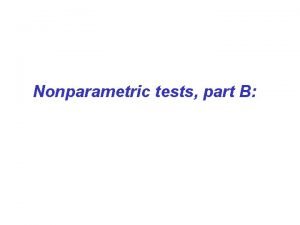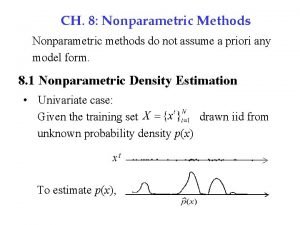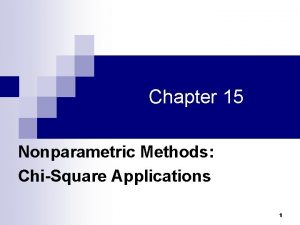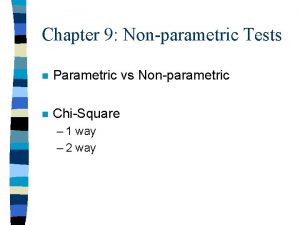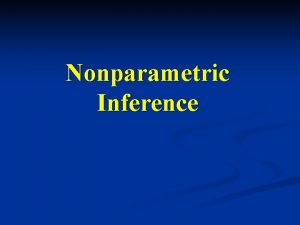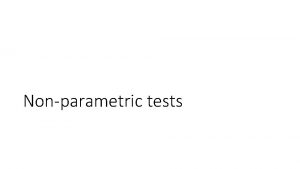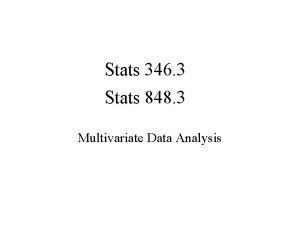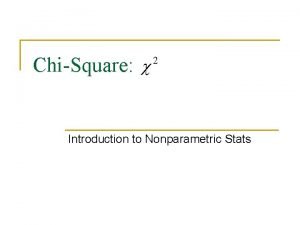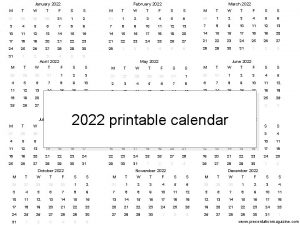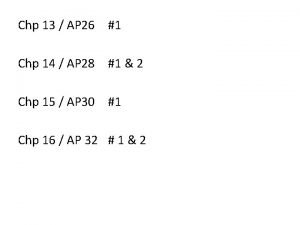Stats 2022 n NonParametric Approaches to Data Chp












































- Slides: 44

Stats 2022 n Non-Parametric Approaches to Data Chp 15. 5 & Appendix E

Outline Chp 15. 5 Spearman Correlation Example alternative to Pearson correlation Appendix E Mann - Whitney U-Test Example Wilcoxon signed-rank test Example Kruskal – Wallace Test Friedman Test independent measures t test repeated-measures t test independent measures ANOVA) (repeated measures ANOVA)

A note on ordinal scales • An ordinal scale : Example – Grades

A note on ordinal scales Ordinal scales allow ranking Example – Grades

Why use ordinal scales? • Some data is easier collected as ordinal – –

The case for ranking data 1. Ordinal data needs to be ranked before it can be tested (via non-parametric tests) 2. Transforming data through ranking can be a useful tool

The case for ranking data Ranking data (rank transform) can be a useful tool – If assumptions of a test are not (or cannot be) met… – Common if data has: • Non linear relationship … • Unequal variance… • High variance … – Data sometimes requires rank transformation for analysis

Rank Transformation Group A 8 98 58 78 Group B 54 82 92 23 A Ranks 1 8 4 5 B Ranks 3 6 7 2

Rank Transformation What if ties? . . Group A 8 8 8 7 Group B 6 6 2 1

Ordinal Transformation Ranking Data, If Ties Group A Group B 8 6 8 2 7 1 Group B B A A scores (ordered) 1 2 6 6 7 8 8 8 rank 1 2 3 4 5 6 7 8 rank (tie adjusted) 1 2 3. 5 5 7 7 7 A Ranks 1 2 3. 5 B Ranks 5 7 7 7

Chp 15. 5 Spearman Correlation

Spearman Correlation Only requirement – ability to rank order data • Data already ranked • Rank transformed data Rank transform useful if relationship non-linear…

Spearman Correlation Example Participant A B C D E F x 4 2 2 10 3 7 12 y 9 6 2 10 8 10 10 8 6 4 2 0 0 Participant A B C D E F x 4 2 2 10 3 7 y 9 6 2 10 8 10 x rank 4 1. 5 6 3 5 y rank 4 2 1 5. 5 3 5. 5 2 4 6 8 10 12 6 5 4 3 2 1 0 0 5 10

Spearman Correlation Calculation x rank y rank 4 4 1. 5 2 1. 5 1 6 5. 5 3 3 5 5. 5 21 21 xy 16 3 1. 5 33 9 27. 5 90 x 2 16 2. 25 36 9 25 90. 5 21 21 90. 5 90 y 2 16 4 1 30. 25 90. 5

Spearman Correlation Calculation 21 21 90. 5 90

Spearman Correlation Special Formula x rank y rank 4 4 1. 5 2 1. 5 1 6 5. 5 3 3 5 5. 5 D 0 0. 5 -0. 5 0 0. 5 D 2 0 0. 25 0 1

Spearman Correlation Special Formula x rank y rank 4 4 1. 5 2 1. 5 1 6 5. 5 3 3 5 5. 5 v. s. D 0 0. 5 -0. 5 0 0. 5 D 2 0 0. 25 0 1

Hypothesis testing with spearman • Same process as Pearson – (still using table B. 7)

Appendix E Mann - Whitney U-Test Wilcoxon signed-rank test Kruskal – Wallace Test Friedman Test

Mann - Whitney U-Test – Requirements • • – Hypotheses: • •

Mann - Whitney U-Test Illustration Extreme difference due to conditions Distributions of ranks unequal No difference due to conditions Distributions of ranks unequal Sample A Ranks Sample B Ranks 1 6 1 2 2 7 3 4 3 8 5 6 4 9 7 8 5 10 9 10

Mann - Whitney U-Test Example Group A Group B 8 54 98 82 58 92 78 23 42 53 14 41 63 28 84 25 Group Score A 8 A 98 A 58 A 78 A 42 A 14 A 63 A 84 B 54 B 82 B 92 B 23 B 53 B 41 B 28 B 25 ranked (sorted) according to values Group Score Rank A 8 1 A 14 2 B 23 3 B 25 4 B 28 5 B 41 6 A 42 7 B 53 8 B 54 9 A 58 10 A 63 11 A 78 12 B 82 13 A 84 14 B 92 15 A 98 16

Mann - Whitney U-Test Computing U by hand Group A A B B A A A B A Rank 1 2 3 4 5 6 7 8 9 10 11 12 13 14 15 16 A Ranks B Ranks 1 3 2 4 7 5 10 6 11 8 12 9 14 13 16 15 A Ranks 1 2 7 10 11 12 14 16 UA verify: U=27 0 0 4 6 6 6 7 8 37 8*8= 64 B Ranks 3 4 5 6 8 9 13 15 UB 37+27=64 2 2 3 3 6 7 27

Mann - Whitney U-Test Computing U via formula A Ranks B Ranks 1 3 2 4 7 5 10 6 11 8 12 9 14 13 16 15 73 63 U=27

Mann - Whitney U-Test Evaluating Significance with U H 0: H 1: U=27 alpha = 0. 05, 2 tails, df(8, 8) Critical value = 13 U > critical value, we fail to reject the null The ranks are equally distributed between samples

Mann - Whitney U-Test Write-Up The original scores were ranked ordered and a Mann-Whitney U-test was used to compare the ranks for the n = 8 participants in treatment A and the n = 8 participants in treatment B. The results indicate no significant difference between treatments, U = 27, p >. 05, with the sum of the ranks equal to 27 for treatment A and 37 for treatment B.

Mann - Whitney U-Test Evaluating Significance Using Normal Approximation With n>20, the MW-U distribution tends to approximate a normal shape, and so, can be evaluated using a z-score statistic as an alternative to the MW-U table. U=27 Note: n not > 20!

Mann - Whitney U-Test Evaluating Significance Using Normal Approximation alpha = 0. 05 2 tails Critical value: z = ± 1. 96 -0. 5251 is not in the critical region Fail to reject the null.

Wilcoxon signed-rank test Requirements • Two related samples (repeated measure) • Rank ordered data Hypotheses: • H 0: • H 1: participant Condition 1 A 1 B 6 C 9 D 7 E 9 F 3 G 2 H 9 I 9 J 3 K 1 Ciondition 2 difference 3 -2 2 4 10 -1 10 -3 4 5 9 -6 2 0 1 8 5 -2 4 -3

Wilcoxon signed-rank test Participant A B C D E F H I J K Difference -2 4 -1 -3 5 -6 8 8 -2 -3 Sorted and ranked by magnitude Participant Difference Rank C -1 1 A -2 2. 5 J -2 2. 5 D -3 4 B 4 5 E 5 6 F -6 7 H 8 8. 5 I 8 8. 5

Wilcoxon signed-rank test Sorted and ranked by magnitude Participant Difference Rank C -1 1 A -2 2. 5 J -2 2. 5 D -3 4 B 4 5 E 5 6 F -6 7 H 8 8. 5 I 8 8. 5 Positive Negative rank scores 5 1 6 2. 5 8. 5 4 7 28 17 T= 17

Wilcoxon signed-rank test n=10 alpha =. 05 two tales critical value = 8 T= 17 T obtained > critical value, fail to reject the null The difference scores are not systematically positive or systematically negative.

Wilcoxon signed-rank test Write up The 11 participants were rank ordered by the magnitude of their difference scores and a Wilcoxon T was used to evaluate the significance of the difference between treatments. One sample was removed due to having a zero difference score. The results indicate no significant difference, n = 10, T = 17, p <. 05, with the positive ranks totaling 28 and the negative ranks totaling 17.

Wilcoxon signed-rank test A note on difference scores of zero Participant Difference C 0 A 2 J -2 D -3 B 4 Participant Difference C 0 A 0 J 0 D -3 B 4 Rank 1. 5 3 4 5 Rank 1 1. 5 3 4 N=4 Positive rank scores 1. 5 4 Negative rank scores 1. 5 3 5. 5 4. 5 Positive rank scores 1. 5 5 N=4 Negative rank scores 1. 5 3 4 6. 5 Positive rank scores 1. 5 4 5. 5 8. 5 Negative rank scores 1. 5 3 4. 5

Wilcoxon signed-rank test Evaluating Significance Using Normal Approximation T= 17 n= 10 Note: n not > 20!

Wilcoxon signed-rank test Evaluating Significance Using Normal Approximation alpha = 0. 05 2 tails Critical value: z = ± 1. 96 -0. 21847 is not in the critical region Fail to reject the null.

Interim Summary Calculation of Mann-Whitney or Wilcoxon is fair game on test. When to use Mann-Whitney or Wilcoxon • If data is already ordinal or ranked • If assumptions of parametric test are not met

Kruskal – Wallace Test • Alternative to independent measures ANOVA • Expands Mann – Whitney • Requirements • Null –

Kruskal – Wallace Test • Rank ordered data (all conditions)

Kruskal – Wallace Test For each treatment condition • n: n for each group • T: sum of ranks for each group Overall • N: Total participants Statistic identified with H Distribution approximates same distribution as chi-squared (i. e. use the chi squared table)

Friedman Test • Alternative to repeated measures ANOVA • Expands Wilcoxon test • Requirements • Null

Friedman Test • Rank ordered data (within each participant)

Friedman Test •

Summary Ratio Data Groups 2 Ranked Data 3+ Groups Independent measure Independen t measure Repeated measure 2 3+
 When do we use friedman test
When do we use friedman test Parametric vs nonparametric test
Parametric vs nonparametric test Nonparametric tests
Nonparametric tests Mann-whitney u test vs t-test
Mann-whitney u test vs t-test Nonparametric methods
Nonparametric methods Types of statistics
Types of statistics Douwe postmus
Douwe postmus Chp bit inspection
Chp bit inspection Hardvarf
Hardvarf Market research igcse
Market research igcse Integrated program design
Integrated program design Matthew 5
Matthew 5 Basic hand tools
Basic hand tools Chp mission statement
Chp mission statement Chp 4
Chp 4 Chp 14
Chp 14 Chp dre
Chp dre Seleccion disruptiva
Seleccion disruptiva Community housing partners
Community housing partners A comparison of approaches to large-scale data analysis
A comparison of approaches to large-scale data analysis Data cleaning problems and current approaches
Data cleaning problems and current approaches Data integration problems approaches and perspectives
Data integration problems approaches and perspectives Statistics complement rule
Statistics complement rule What is statistic
What is statistic Wait stats in sql server
Wait stats in sql server It&m stats
It&m stats Contrast and contradiction examples
Contrast and contradiction examples What is p hat stats
What is p hat stats Modality in statistics
Modality in statistics Chapter 24 paired samples and blocks
Chapter 24 paired samples and blocks Ap stats practice test multiple choice
Ap stats practice test multiple choice Ap statistics chapter 7a test answer key
Ap statistics chapter 7a test answer key Statistics symbols
Statistics symbols Mrs daniel ap stats
Mrs daniel ap stats Jared derksen
Jared derksen Stats refund
Stats refund Conditions for regression inference
Conditions for regression inference Matched pairs design statistics
Matched pairs design statistics Stats 330
Stats 330 Riak cs stats
Riak cs stats Parameter and statistics
Parameter and statistics Word gaps signpost
Word gaps signpost Stats$sql_summary
Stats$sql_summary Mobile commerce stats
Mobile commerce stats Stat 134
Stat 134
